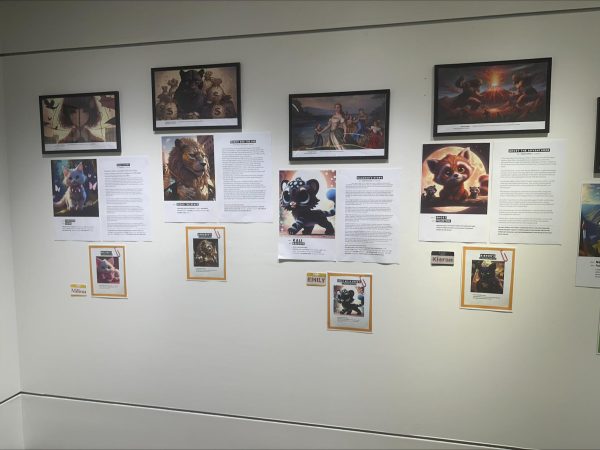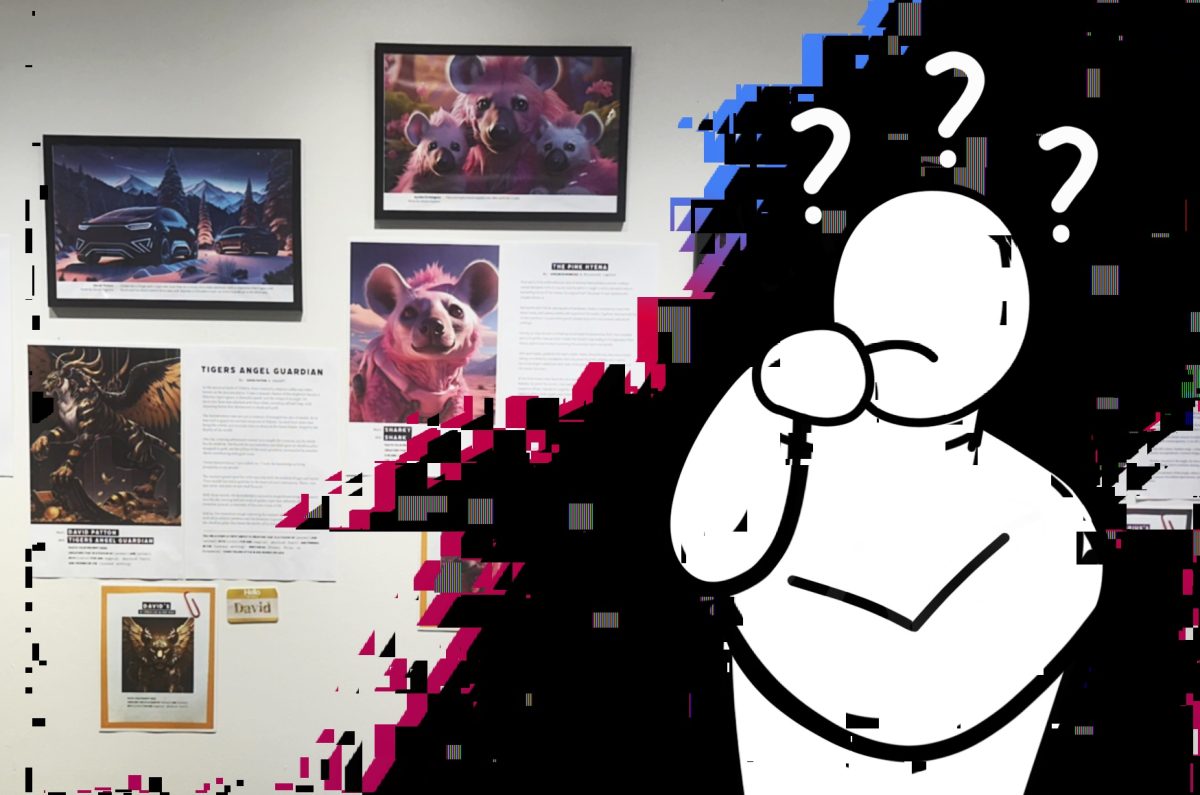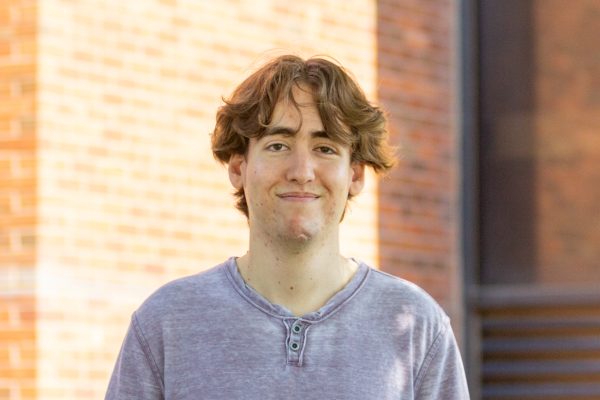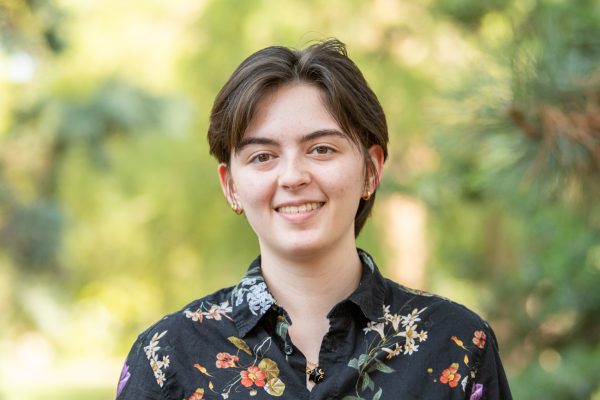Early in July, Wichita State sophomore Michael Miller was walking through the Rhatigan Student Center when he noticed a new display being put up in the Wilson K. Cadman Art Gallery. Looking closer, Miller realized the images were generated by artificial intelligence.
“I saw it being put up … and I was immediately like, ‘Why would they be displaying AI art in an art gallery that’s supposed to be (for) actual art?’” Miller said.
The display was a compilation of work from a generative AI course in the Upward Bound program, which allows select low-income or potential first-generation USD 259 students to stay on Wichita State’s campus and take classes over the summer.
Depending on who you ask, AI-generated art could enhance human creativity and productivity or completely destroy human artistry. Amidst the ongoing debate, some Wichita State students expressed frustration with the university teaching the benefits of generative AI to high schoolers and displaying the works in a public art gallery.
The class
Fennie Christensen, the instructor for the Upward Bound AI class, said the course taught students about the ethics of generative AI. Using a variety of platforms, including Adobe, Canva and Microsoft Copilot, students tailored prompts to generate their “alter ego,” an image that represented them.
Then, students used Chat GPT to generate a story involving the alter ego before manually editing it themselves. At the end of the class, the students’ images, stories and prompts were displayed in the Cadman Gallery for their families and passersby to see.
“As people went through the gallery, they can see, ‘Oh, they actually have thought and process put in in order to generate (the) art,’” Christensen said.
When Miller, who is an artist in his free time, came across the gallery, he didn’t see a creative process. He saw “soulless creations.”
“Art, its most fundamental thing is … (that it’s) a creation of the soul; a creation of a human,” Miller said. “It’s not something that a computer can do.”
The exhibit
Maria Ciski, the director of the RSC’s event services, manages the Cadman Gallery. She said she views the gallery as a space where “WSU students have the opportunity to be able to demonstrate their artistic efforts.”
“As far as AI-generated art itself, I’d like to tell you that I know more about it, but I really don’t,” Ciski said. “Like many people, I am new to this and still kind of learning more.”

The AI gallery was up for a shorter period of time than most other exhibits in the space. Ciski wouldn’t commit to an answer on whether the Cadman Exhibit will allow AI-generated works in its exhibits in the future, saying it’s “a new area that museums will explore.”
“We weren’t passing judgment one way or the other, but rather offering the space to a visual arts class,” Ciski said. “And I think that’s an important role that the Cadman has to play, is to make sure that we’re available for the expression of all kinds of art for WSU students.”
The reactions
Miller said his main concern wasn’t the use of AI in general, but “how it’s being displayed.” He said AI art should be displayed where computer science classes are taught, and added that if the Cadman is willing to allow non-human works in its gallery, the space should be renamed from an “art gallery” to a “display place.”
“You should only have it in the context of the ethics and the problems it has as an emerging technology, and not displaying in a place where there’s supposed to be art — human-created art,” Miller said.
Collin Schmidt, a sophomore creative writing major at WSU who describes himself as an “artist and writer at heart,” thought the gallery space should be reserved for human artists.
“Plenty of artists would love to get their artwork noticed and shown … and that can actually help them in a business sense, too,” Schmidt said.
Ciski said groups renting the space decide how the exhibition looks in the gallery. She reviews each presentation but does not put it up herself.
Miller said it was not made clear to onlookers that the art was AI-generated. Christensen argued otherwise.
“We don’t want the audience to have a confusion of, ‘Is it a student that painted this?’” Christensen said. “And that’s why underneath each of the digital art (pieces), not only did the student credit themselves, they also credit the bot or the AI tool that they utilize … So there’s no mistaking that this is a collaboration between a human, you know, and a tool.”
The debate
Christensen addressed fears about AI-generated art but argued that many concerns don’t have merit. In the class, she asked students about their fears regarding the new technology. They worried it would “take over the world.”
“Technology is going to advance,” Christensen said. “The longer we live on this earth, the more advanced technology is going to be, and it is a way for us to be more productive. It’s cost-effective. But no, it would never replace the human.”
Miller and Schmidt didn’t argue that AI will take over the world. But both prospective artists did express concerns that the advanced technology is unethical and could replace human artists in the future.
“AI kind of takes from other artists and writers … and tries to replicate it, and (AI) ends up replacing the artist, especially in professional fields, where that is very much a priority to be efficient and cheap,” Schmidt said.
Christensen said because the AI generation process requires prompts that humans must input, humans will remain involved in art production.
“(It) still involves a human, right, to input something, so you’re telling it what to do,” Christensen said. “And then you’re still massaging the output. It is not like you click a button, and (it’s) done … There will always be the human factor in (this) kind of generative AI.”
Miller said that while AI can create an image using a human prompt, that picture doesn’t have the “essence” and “humanity” of art made by hand.
“You’re just … taking people’s art and then outputting a soulless creation, and then you’re not doing any of the work that it takes to create that creation,” he said.
Generative AI models are trained on billions of pieces of text and image data from across the internet, often copyrighted works. Christensen said she showed a YouTube video in the class about how artists can opt out of allowing the AI models to train on their work.
However, the process of opting out can be tedious, and it’s impossible to know how much data – from images to articles to social media posts — the machine learning algorithms have already been fed.
“This is very unethical in the … way that these things, these models have been generated because you’re feeding them copyrighted works,” Miller said.
Christensen also claimed that generative AI could increase productivity. Christensen said the technology allows someone to create an image or flyer quickly and for free when, in the past, they would have hired a graphic designer. She said this gives us “the tools to be more independent.”
“I don’t see the generative AI going away anytime soon,” Christensen said. “Now, they might change or shape it differently, but it will be integrated in most of the tools that we do. And when people have the tools at the fingertip, they feel … empowered to do more. They don’t have to spend more time to hire or seek out designers or artists and whatnot to do (those) small little things that they need.”
Where Christensen sees empowerment, Schmidt sees less work for artists and a loss of human expression.
“It’s something that could be very dangerous to just replace it all by automation and AI,” Schmidt said. “And I think that the fact that WSU is offering a class in this AI program just makes me feel like they don’t value artists, in a way.”
Christensen, who says she’s a “designer by day,” expressed a far more hopeful perspective of the future.
“The job will evolve, just like any industry … maybe the job of the designer no longer designs specifically for the flyer,” Christensen said. “They are the brain behind the engine itself … It’s still using their skill. It’s just not in a traditional way to design it.”





